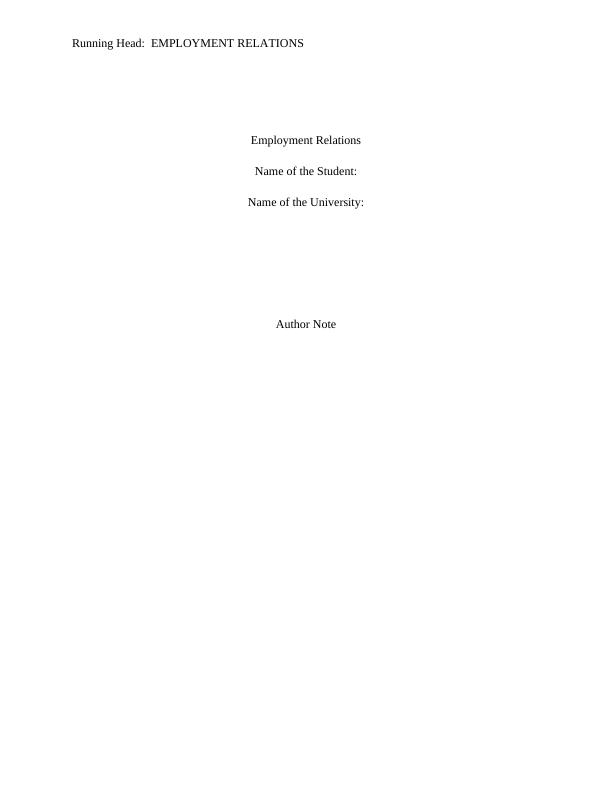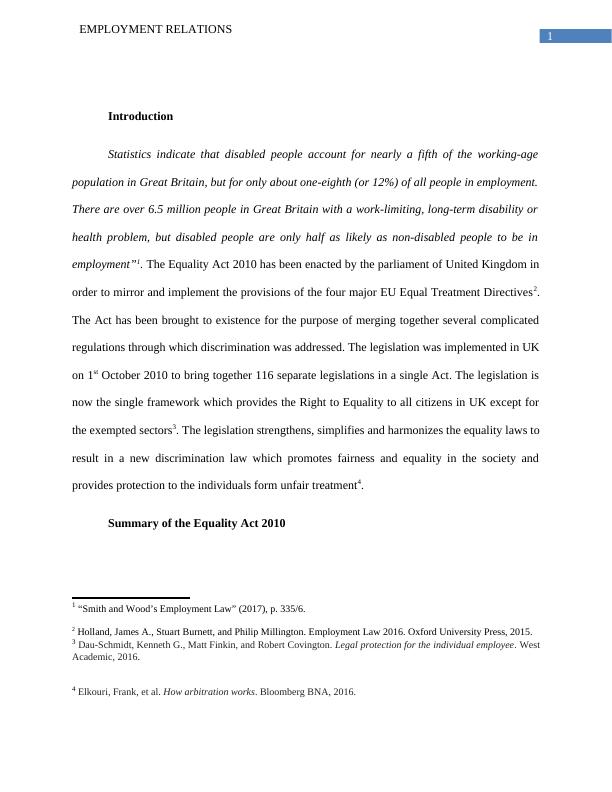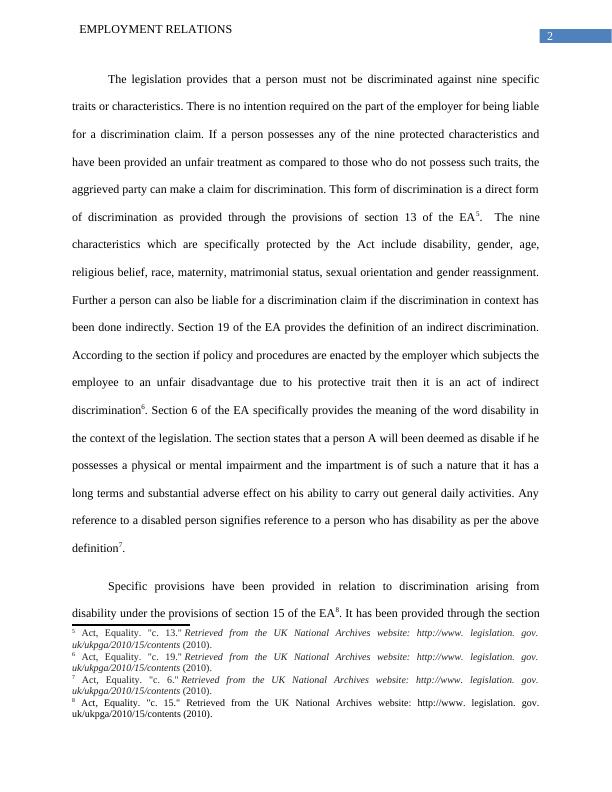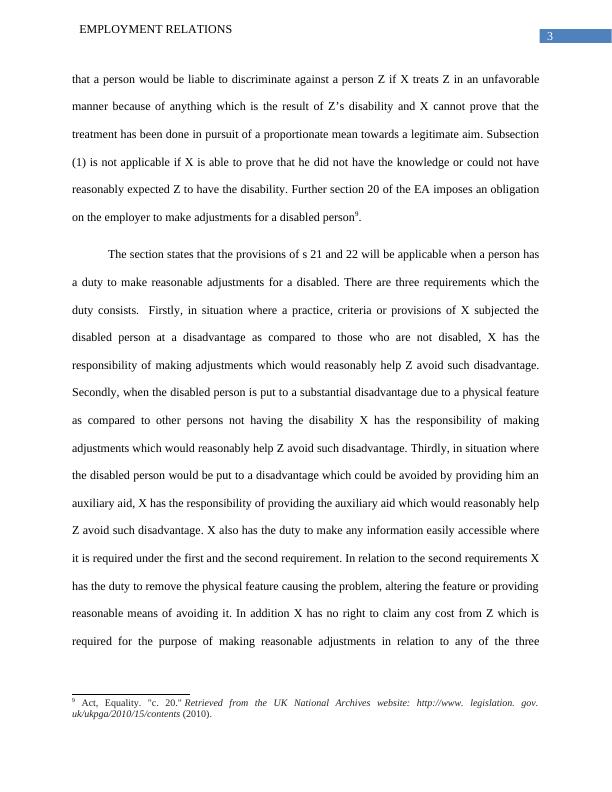Employment Relations: Understanding Disability Discrimination and Reasonable Adjustments
Added on 2023-06-14
12 Pages3537 Words203 Views
Running Head: EMPLOYMENT RELATIONS
Employment Relations
Name of the Student:
Name of the University:
Author Note
Employment Relations
Name of the Student:
Name of the University:
Author Note

1
EMPLOYMENT RELATIONS
Introduction
Statistics indicate that disabled people account for nearly a fifth of the working-age
population in Great Britain, but for only about one-eighth (or 12%) of all people in employment.
There are over 6.5 million people in Great Britain with a work-limiting, long-term disability or
health problem, but disabled people are only half as likely as non-disabled people to be in
employment”1. The Equality Act 2010 has been enacted by the parliament of United Kingdom in
order to mirror and implement the provisions of the four major EU Equal Treatment Directives2.
The Act has been brought to existence for the purpose of merging together several complicated
regulations through which discrimination was addressed. The legislation was implemented in UK
on 1st October 2010 to bring together 116 separate legislations in a single Act. The legislation is
now the single framework which provides the Right to Equality to all citizens in UK except for
the exempted sectors3. The legislation strengthens, simplifies and harmonizes the equality laws to
result in a new discrimination law which promotes fairness and equality in the society and
provides protection to the individuals form unfair treatment4.
Summary of the Equality Act 2010
1 “Smith and Wood’s Employment Law” (2017), p. 335/6.
2 Holland, James A., Stuart Burnett, and Philip Millington. Employment Law 2016. Oxford University Press, 2015.
3 Dau-Schmidt, Kenneth G., Matt Finkin, and Robert Covington. Legal protection for the individual employee. West
Academic, 2016.
4 Elkouri, Frank, et al. How arbitration works. Bloomberg BNA, 2016.
EMPLOYMENT RELATIONS
Introduction
Statistics indicate that disabled people account for nearly a fifth of the working-age
population in Great Britain, but for only about one-eighth (or 12%) of all people in employment.
There are over 6.5 million people in Great Britain with a work-limiting, long-term disability or
health problem, but disabled people are only half as likely as non-disabled people to be in
employment”1. The Equality Act 2010 has been enacted by the parliament of United Kingdom in
order to mirror and implement the provisions of the four major EU Equal Treatment Directives2.
The Act has been brought to existence for the purpose of merging together several complicated
regulations through which discrimination was addressed. The legislation was implemented in UK
on 1st October 2010 to bring together 116 separate legislations in a single Act. The legislation is
now the single framework which provides the Right to Equality to all citizens in UK except for
the exempted sectors3. The legislation strengthens, simplifies and harmonizes the equality laws to
result in a new discrimination law which promotes fairness and equality in the society and
provides protection to the individuals form unfair treatment4.
Summary of the Equality Act 2010
1 “Smith and Wood’s Employment Law” (2017), p. 335/6.
2 Holland, James A., Stuart Burnett, and Philip Millington. Employment Law 2016. Oxford University Press, 2015.
3 Dau-Schmidt, Kenneth G., Matt Finkin, and Robert Covington. Legal protection for the individual employee. West
Academic, 2016.
4 Elkouri, Frank, et al. How arbitration works. Bloomberg BNA, 2016.

2
EMPLOYMENT RELATIONS
The legislation provides that a person must not be discriminated against nine specific
traits or characteristics. There is no intention required on the part of the employer for being liable
for a discrimination claim. If a person possesses any of the nine protected characteristics and
have been provided an unfair treatment as compared to those who do not possess such traits, the
aggrieved party can make a claim for discrimination. This form of discrimination is a direct form
of discrimination as provided through the provisions of section 13 of the EA5. The nine
characteristics which are specifically protected by the Act include disability, gender, age,
religious belief, race, maternity, matrimonial status, sexual orientation and gender reassignment.
Further a person can also be liable for a discrimination claim if the discrimination in context has
been done indirectly. Section 19 of the EA provides the definition of an indirect discrimination.
According to the section if policy and procedures are enacted by the employer which subjects the
employee to an unfair disadvantage due to his protective trait then it is an act of indirect
discrimination6. Section 6 of the EA specifically provides the meaning of the word disability in
the context of the legislation. The section states that a person A will been deemed as disable if he
possesses a physical or mental impairment and the impartment is of such a nature that it has a
long terms and substantial adverse effect on his ability to carry out general daily activities. Any
reference to a disabled person signifies reference to a person who has disability as per the above
definition7.
Specific provisions have been provided in relation to discrimination arising from
disability under the provisions of section 15 of the EA8. It has been provided through the section
5 Act, Equality. "c. 13." Retrieved from the UK National Archives website: http://www. legislation. gov.
uk/ukpga/2010/15/contents (2010).
6 Act, Equality. "c. 19." Retrieved from the UK National Archives website: http://www. legislation. gov.
uk/ukpga/2010/15/contents (2010).
7 Act, Equality. "c. 6." Retrieved from the UK National Archives website: http://www. legislation. gov.
uk/ukpga/2010/15/contents (2010).
8 Act, Equality. "c. 15." Retrieved from the UK National Archives website: http://www. legislation. gov.
uk/ukpga/2010/15/contents (2010).
EMPLOYMENT RELATIONS
The legislation provides that a person must not be discriminated against nine specific
traits or characteristics. There is no intention required on the part of the employer for being liable
for a discrimination claim. If a person possesses any of the nine protected characteristics and
have been provided an unfair treatment as compared to those who do not possess such traits, the
aggrieved party can make a claim for discrimination. This form of discrimination is a direct form
of discrimination as provided through the provisions of section 13 of the EA5. The nine
characteristics which are specifically protected by the Act include disability, gender, age,
religious belief, race, maternity, matrimonial status, sexual orientation and gender reassignment.
Further a person can also be liable for a discrimination claim if the discrimination in context has
been done indirectly. Section 19 of the EA provides the definition of an indirect discrimination.
According to the section if policy and procedures are enacted by the employer which subjects the
employee to an unfair disadvantage due to his protective trait then it is an act of indirect
discrimination6. Section 6 of the EA specifically provides the meaning of the word disability in
the context of the legislation. The section states that a person A will been deemed as disable if he
possesses a physical or mental impairment and the impartment is of such a nature that it has a
long terms and substantial adverse effect on his ability to carry out general daily activities. Any
reference to a disabled person signifies reference to a person who has disability as per the above
definition7.
Specific provisions have been provided in relation to discrimination arising from
disability under the provisions of section 15 of the EA8. It has been provided through the section
5 Act, Equality. "c. 13." Retrieved from the UK National Archives website: http://www. legislation. gov.
uk/ukpga/2010/15/contents (2010).
6 Act, Equality. "c. 19." Retrieved from the UK National Archives website: http://www. legislation. gov.
uk/ukpga/2010/15/contents (2010).
7 Act, Equality. "c. 6." Retrieved from the UK National Archives website: http://www. legislation. gov.
uk/ukpga/2010/15/contents (2010).
8 Act, Equality. "c. 15." Retrieved from the UK National Archives website: http://www. legislation. gov.
uk/ukpga/2010/15/contents (2010).

3
EMPLOYMENT RELATIONS
that a person would be liable to discriminate against a person Z if X treats Z in an unfavorable
manner because of anything which is the result of Z’s disability and X cannot prove that the
treatment has been done in pursuit of a proportionate mean towards a legitimate aim. Subsection
(1) is not applicable if X is able to prove that he did not have the knowledge or could not have
reasonably expected Z to have the disability. Further section 20 of the EA imposes an obligation
on the employer to make adjustments for a disabled person9.
The section states that the provisions of s 21 and 22 will be applicable when a person has
a duty to make reasonable adjustments for a disabled. There are three requirements which the
duty consists. Firstly, in situation where a practice, criteria or provisions of X subjected the
disabled person at a disadvantage as compared to those who are not disabled, X has the
responsibility of making adjustments which would reasonably help Z avoid such disadvantage.
Secondly, when the disabled person is put to a substantial disadvantage due to a physical feature
as compared to other persons not having the disability X has the responsibility of making
adjustments which would reasonably help Z avoid such disadvantage. Thirdly, in situation where
the disabled person would be put to a disadvantage which could be avoided by providing him an
auxiliary aid, X has the responsibility of providing the auxiliary aid which would reasonably help
Z avoid such disadvantage. X also has the duty to make any information easily accessible where
it is required under the first and the second requirement. In relation to the second requirements X
has the duty to remove the physical feature causing the problem, altering the feature or providing
reasonable means of avoiding it. In addition X has no right to claim any cost from Z which is
required for the purpose of making reasonable adjustments in relation to any of the three
9 Act, Equality. "c. 20." Retrieved from the UK National Archives website: http://www. legislation. gov.
uk/ukpga/2010/15/contents (2010).
EMPLOYMENT RELATIONS
that a person would be liable to discriminate against a person Z if X treats Z in an unfavorable
manner because of anything which is the result of Z’s disability and X cannot prove that the
treatment has been done in pursuit of a proportionate mean towards a legitimate aim. Subsection
(1) is not applicable if X is able to prove that he did not have the knowledge or could not have
reasonably expected Z to have the disability. Further section 20 of the EA imposes an obligation
on the employer to make adjustments for a disabled person9.
The section states that the provisions of s 21 and 22 will be applicable when a person has
a duty to make reasonable adjustments for a disabled. There are three requirements which the
duty consists. Firstly, in situation where a practice, criteria or provisions of X subjected the
disabled person at a disadvantage as compared to those who are not disabled, X has the
responsibility of making adjustments which would reasonably help Z avoid such disadvantage.
Secondly, when the disabled person is put to a substantial disadvantage due to a physical feature
as compared to other persons not having the disability X has the responsibility of making
adjustments which would reasonably help Z avoid such disadvantage. Thirdly, in situation where
the disabled person would be put to a disadvantage which could be avoided by providing him an
auxiliary aid, X has the responsibility of providing the auxiliary aid which would reasonably help
Z avoid such disadvantage. X also has the duty to make any information easily accessible where
it is required under the first and the second requirement. In relation to the second requirements X
has the duty to remove the physical feature causing the problem, altering the feature or providing
reasonable means of avoiding it. In addition X has no right to claim any cost from Z which is
required for the purpose of making reasonable adjustments in relation to any of the three
9 Act, Equality. "c. 20." Retrieved from the UK National Archives website: http://www. legislation. gov.
uk/ukpga/2010/15/contents (2010).

End of preview
Want to access all the pages? Upload your documents or become a member.
Related Documents
Law and Equality at Work: Case Lawlg...
|12
|1960
|374
ASS071-1 Business And Corporation Law Discussion 2022lg...
|10
|1810
|15
Equality Act 2010 and Employee Rights: A Case Studylg...
|11
|2850
|392
Employee Law and Relations : Assignmentlg...
|14
|2932
|72
Case Study Of Law - Equality Actlg...
|11
|1684
|360
Law, Society and Controversylg...
|9
|1695
|56
